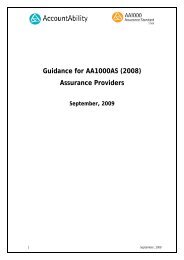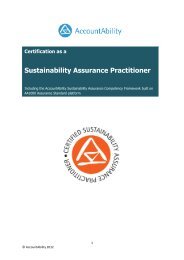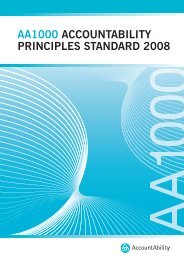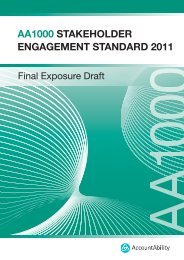The Stakeholder Engagement Manual Volume 2 - AccountAbility
The Stakeholder Engagement Manual Volume 2 - AccountAbility
The Stakeholder Engagement Manual Volume 2 - AccountAbility
Create successful ePaper yourself
Turn your PDF publications into a flip-book with our unique Google optimized e-Paper software.
Engage with your stakeholders in ways that work<br />
P15: DESIGNING THE ENGAGEMENT PROCESS<br />
BACKGROUND<br />
Within any engagement process, there are a number of design issues which you<br />
need to consider and prepare for. If you are working with an external facilitator<br />
they may address some of these issues with you.<br />
When designing the engagement process, <strong>Volume</strong> 1 of the <strong>Stakeholder</strong> <strong>Engagement</strong> <strong>Manual</strong>,<br />
the Guide to Practitioners’ Perspectives on <strong>Stakeholder</strong> <strong>Engagement</strong>, provides useful<br />
guidance, case studies and recommendations regarding the requirements and expectations<br />
of specifi c stakeholder groups and types of initiatives.<br />
Practical Issues - A Checklist<br />
Scope – determined by the margins of movement<br />
In Stage 3, you have already considered your margins of movement.<br />
<strong>The</strong> margins of movement defi ne the scope of the engagement process: what<br />
issues are up for discussion and which aren’t.<br />
Be clear in your communications with stakeholders such as invitations, written<br />
material and presentations about the scope and aims of the engagement.<br />
Make sure that the external facilitators, internal staff , meeting chairs and<br />
workshop leaders are clear about the scope and objectives.<br />
Orange’s <strong>Stakeholder</strong> <strong>Engagement</strong> Around Transmitter Sites<br />
Mobile phone network operating company Orange engages with local communities in order<br />
to identify and ideally agree on the best possible location for new mobile phone transmitter<br />
masts within the area. However, Orange makes clear from the start that its intention is to fi nd<br />
a location for its mast, not discuss the question of whether masts should be put up at all.<br />
Allow for a re-evaluation of materiality<br />
Be aware that in many engagement your stakeholders may raise issues that are<br />
outside of the scope of engagement. While it is important to be clear about your<br />
scope and to ensure that you are not derailed by less material issues, it is also<br />
crucial that you do not brush away new issues light-heartedly. Consider any other<br />
issues that stakeholders may have - in advance if possible – and if unexpected<br />
during the engagement. Some unanticipated issues may even be more important<br />
than the subject of the planned engagement. As meaningful engagement will be<br />
diffi cult if your stakeholders consider the topic as relatively irrelevant compared<br />
to other concerns they may have regarding your company’s activities, you need<br />
to stay fl exible and willing to reconsider your approach and priorities during the<br />
engagement process. However, at the same time, it may still be necessary to ‘park’<br />
the new issue in order to not get distracted from nevertheless material issues of<br />
the current engagement. Your stakeholders are most likely to agree to this if you<br />
are prepared to make a clear and timed commitment to when and how you will<br />
address the other material issues with them.

















